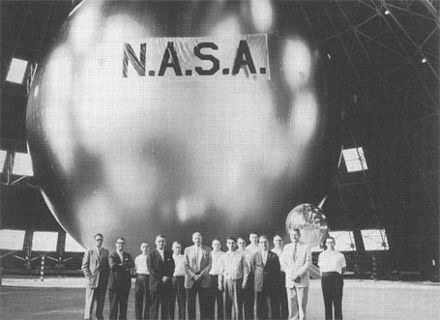Project Echo... I ran across a reference to this early space age project in my reading this morning, and that sent me off to read about it. Two Echo satellites made it to orbit: Echo 1 (5/13/1960 - 5/24/1960) and Echo 2 (1/25/1964 - 6/7/1969).
These satellites were enormous by today's standards: Echo 1 was 100 feet in diameter, and Echo 2 was 135 feet in diameter. Both were metalized Mylar balloons, and both were intended to be used as passive communications satellites – simple reflectors in space. Today's communications satellites are all either simple repeaters (devices with a radio receiver tied directly to a radio transmitter that simply retransmits an amplified version of whatever it “hears”) or more sophisticated routers (all-digital repeaters that not only amplify a signal, but can also send it through a particular antenna to the right part of the Earth's surface).
I have two memories of the Echo project. The first one was from shortly after Echo 1's launch in 1960, when I was just 8 years old. Because Echo 1 was so large, and had a mirror finish (reflective in visible light, not just radio frequencies), it was extremely bright for a satellite. That made it very easy to spot with the naked eye, and I remember standing outside at dusk with my Uncle Donald, in a soy bean field near his apple orchard, watching it transition overhead from horizon to horizon. It's funny how these old memories work – I remember it being my uncle that I was with, but I have no idea why. My Uncle Donald was not generally interested in space; he was into archaeology, fungi, and history...
The second memory is from several years later, when I was old enough to drive, still living in New Jersey, and was starting to design and build my own radio receivers and transmitters – most likely, in the late '60s. The first radio signals bounced off the Echo 1 satellite were transmitted from California and received in New Jersey. The receiver was a gigantic horn antenna (the Holmdel Horn Antenna), especially built at Bell Labs for the purpose. Later, in 1965, radio astronomers Arno Penzias and Robert Wilson used this same antenna to discover the cosmic microwave background radiation, which completely revolutionized cosmology.
This antenna was just 30 miles or so from the farm I grew up on (see map at left), and I drove up there one day to see if I could get a peek at it. At the time it was still privately owned by Bell Labs, and there was a fence keeping the public away – but one of the employees there saw me gawking through the fence and offered up a tour. For me the exciting part was in the little hut that you can see to the left of the antenna in the photo, with one window in it. The microwave receiver electronics were located in that shack, all custom-built stuff using the absolute latest and greatest. That employee turned out to be a technician who kept the gear tuned up (the microwave equipment of the day needed nearly constant attention to stay in tune), and very knowledgeable about the equipment. The main takeaway for me was a keenly whetted interest in bleeding-edge radio technology. When I enlisted in the U.S. Navy not long afterwards, that sort of technology is what I desperately wanted to learn about. Instead, they sent me off to learn about those boring old computers :)



No comments:
Post a Comment